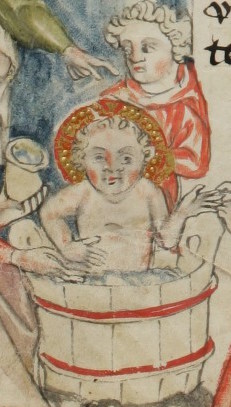Have you heard the NEW Good News? Back in the day, when Jesus was still just a guy people were figuring out what to do with, the word “gospel” meant something like “good news.” Just this week, all sorts of news outlets are reporting about a gospel fragment in the Carl von Ossietzky State and University Library in Hamburg, Germany. Headlines say things like “1,600-year-old fragment identified as oldest written account of Jesus Christ’s childhood” or “An account of Jesus as a boy is decoded from an ancient papyrus scrap.”

People keep sending me news stories about this, or tagging me for my response, so here are some thoughts. First, I think that this is a really cool find, and I think that people should be excited about it. But I seem to have different reasons to be excited than news outlets do.
Right off the bat: this is not a “new” gospel or a new piece of historical evidence about Jesus. The “discovery” being reported in sensationalist news media is really an identification (there is a distinction) of a papyrus fragment that contains a text we know as the Infancy Gospel of Thomas.
The Infancy Gospel of Thomas is a set of stories about Jesus’s childhood, but it’s not really a historical record as much as it is an early Christian author’s attempt (or the attempt by a group of people working together to write it over time) to wrestle with questions about Jesus’s identity as Christ (or the Messiah): his humanity and divinity in one. For that, it’s fascinating.
Scholars have known about the Infancy Gospel of Thomas for a long time. Scholars have known about the Infancy Gospel of Thomas for a long time: in fact, the historian Peter Lambeck printed a passage from a Greek manuscript of the work in 1675. The Catholic theologian Jean-Baptiste Cotelier published the first scholarly edition (incomplete, though) in 1698. In1703, Johann Albert Fabricius reprinted Cotelier’s text in his famous and popular anthology of Christian apocrypha. By the end of the eighteenth century, it was even more widely published, as Giovanni Luigi Mingarelli published an edition of the full Greek text in 1764. Only about seventy years later, Johannes Carolus Thilo published another Greek edition in 1832. By the middle of the nineteenth century, most scholars of early Christianity knew about the Infancy Gospel of Thomas.
Versions of the Infancy Gospel of Thomas survive in languages like Greek (the original), Syriac, Arabic, Ge’ez, Georgian, Irish, Latin, Church Slavic, Syriac, and Ukrainian. It was pretty popular during the Middle Ages and it was well known across Europe and the Near East. Probably the foremost current scholar on the Infancy Gospel of Thomas is Tony Burke, who has edited various versions of it and who has compiled an entire bibliographic page about it for the North American Society for the Study of Christian Apocryphal Literature.
So what’s the big deal with the news about the Infancy Gospel of Thomas this week? In short, scholars Lajos Berkes and Gabriel Nocchi Macedo have identified a fragment of the text that’s gone unnoticed by scholars before. It’s been sitting in a library (probably known to librarians, and you can see more catalogue information about the papyrus here) waiting for this. And the reason this fragment is a big deal is that it’s the earliest manuscript ever identified: Berkes and Nocchi Macedo date the papyrus fragment to the fourth or fifth century, which is pretty early in the grand scheme of the history of Christianity.
Of course, we knew that the Infancy Gospel of Thomas was old already. Early Christian authors like Irenaeus of Lyon refer to it (sometimes to revile it) in the second and third centuries, and scholars generally agree that the earliest version of the gospel was composed between about 150 and 175ish (give or take some time on either side). In short, Berkes and Nocchi Macedo have identified another fragment that tells us a bit more about the Infancy Gospel of Thomas, how it circulated, and one more piece of evidence that Christians cared about the work and read it despite some authorities rejecting it. The full report of their examination of the papyrus will be published in an article titled “Das früheste Manuskript des sogenannten Kindheitsevangeliums des Thomas: Editio princeps of P.Hamb.Graec. 1011,” or “The Earliest Manuscript of the So-called Infancy Gospel of Thomas: Editio princeps of P. Ham. Graec. 1011,” in the journal Zeitschrift für Papyrologie und Epigraphik, issue 229.
My hope in all of this hubbub (a lot of it sensationalist) is that people gain an interest in apocrypha like the Infancy Gospel of Thomas. It’s important stuff! Even if they don’t tell us about the historical Jesus, biblical apocrypha do tell us about the diversity of Christian beliefs and practices.
